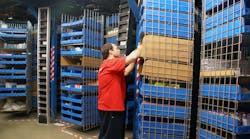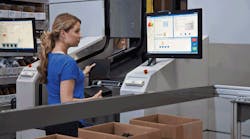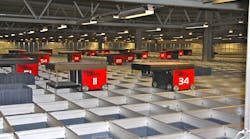Consumers everywhere are demanding faster access to the retail goods they purchase – with next-day delivery having practically become the norm, and same-day delivery and in-store pickup on the rise. Similarly, for many manufacturers and operators of industrial processes, demand is growing for near-real time access to replacement inventory and spare parts to ensure uninterrupted operation.
To meet this customer demand, a growing number of distributors and centralized inventory management warehouses are working on improving warehouse management. The goal is to use a combination of automation technologies and improved workflow processes to reduce the time required to pick, pack and ship items.
A variety of automation technologies are available to improve both the speed and accuracy of the picking process. When such dynamic storage systems are coupled with improved workflow procedures related to order fulfillment, picking and shipping, facilities are able to drastically improve picking times and accuracy – often enabling next-day delivery with later daily cutoff times. This improves overall inventory management within the facility and boosts customer satisfaction.
New Tools, New Strategies
The use of automation efforts related to parts picking and order fulfillment can yield the following improvements:
- Improved Worker Productivity. By bringing products right to the picking personnel, automated picking systems reduce the time and effort required for manual search-and-retrieve efforts, and thus significantly boost picking efficiency, worker productivity and overall throughput rate and volume at the facility. Specifically, the use of automation can increase picking rates by as much as 800% while reducing labor requirements. As a result, staff size can be reduced, or workers can be reassigned to other value-added operations, such as packing, shipping and quality checks to ensure accuracy.
- Improved Picking Accuracy. Today’s software-driven automated picking systems can also improve picking accuracy (to above 99%). This speeds order fulfillment and allows for later cut-off times each day without compromising same-day and next-day delivery guarantees.
- Improved Space Utilization. By maximizing the use of underutilized overhead space from the floor to ceiling, today’s dynamic storage and retrieval systems can reduce traditional floor space requirements by 65-85%. In many cases, this newfound floor space can be used to add inventory, bring existing inventory that is currently stored offiste back under the same roof or for other revenue-generating activities.
- Improved Working Conditions. Automated picking systems can help reduce foot travel throughout the day. The automated carousels at the heart of these systems are ergonomic, presenting items to the workers at waist height.
A variety of automation technologies (horizontal carousels, vertical carousels and vertical lift modules) and optimization strategies are available to help warehouse operators overcome the limitations and inefficiencies of the manual approach. And because these technology options are essentially modular, today’s automated systems can be phased in over time. This gives warehouse managers more flexibility in terms of managing expenses and training issues, and analyzing ongoing results to both fine-tune ongoing optimization efforts and analyze return on investment (ROI).
Chelsea Tarr is marketing communications coordinator for Kardex Remstar, LLC.





